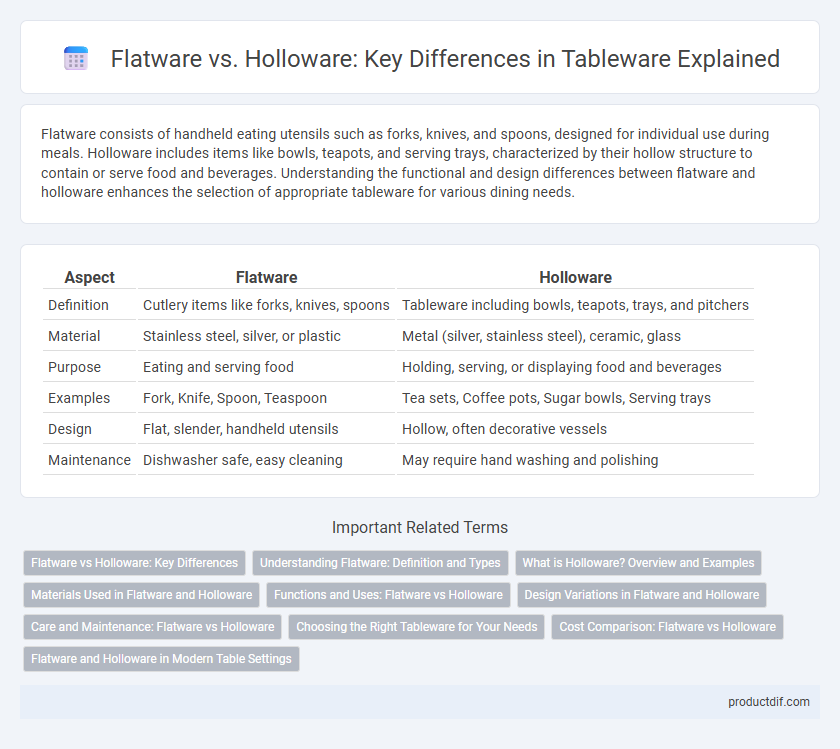Flatware consists of handheld eating utensils such as forks, knives, and spoons, designed for individual use during meals. Holloware includes items like bowls, teapots, and serving trays, characterized by their hollow structure to contain or serve food and beverages. Understanding the functional and design differences between flatware and holloware enhances the selection of appropriate tableware for various dining needs.
Table of Comparison
| Aspect | Flatware | Holloware |
|---|---|---|
| Definition | Cutlery items like forks, knives, spoons | Tableware including bowls, teapots, trays, and pitchers |
| Material | Stainless steel, silver, or plastic | Metal (silver, stainless steel), ceramic, glass |
| Purpose | Eating and serving food | Holding, serving, or displaying food and beverages |
| Examples | Fork, Knife, Spoon, Teaspoon | Tea sets, Coffee pots, Sugar bowls, Serving trays |
| Design | Flat, slender, handheld utensils | Hollow, often decorative vessels |
| Maintenance | Dishwasher safe, easy cleaning | May require hand washing and polishing |
Flatware vs Holloware: Key Differences
Flatware refers to utensils such as knives, forks, and spoons specifically designed for eating and serving food, while holloware includes items like bowls, teapots, and pitchers that are hollow and primarily used for holding liquids or food. The key differences between flatware and holloware lie in their form and function: flatware is flat and primarily used for handling food, whereas holloware is three-dimensional and meant for containing and serving. Material composition often overlaps, including stainless steel and silver, but design and usage distinguish flatware from holloware distinctly in tableware collections.
Understanding Flatware: Definition and Types
Flatware refers to utensils used for eating and serving food, typically made of metal such as stainless steel or silver. Common types of flatware include forks, knives, and spoons, each designed for specific functions like cutting, stabbing, or scooping food. Understanding flatware also involves recognizing specialized pieces such as salad forks, butter knives, and soup spoons, which enhance dining experiences by catering to different courses and cuisines.
What is Holloware? Overview and Examples
Holloware refers to tableware items made from metal that are hollow and used for serving or decorative purposes, including items like teapots, coffee pots, sugar bowls, creamers, and serving trays. Unlike flatware, which comprises utensils such as forks, knives, and spoons, holloware pieces emphasize functionality in serving beverages or food and often showcase intricate designs and craftsmanship. Collectors and enthusiasts value holloware for its historical significance and artistic metalwork, commonly crafted from silver, stainless steel, or pewter.
Materials Used in Flatware and Holloware
Flatware is commonly crafted from stainless steel, silver, or gold-plated alloys, offering durability and resistance to corrosion while maintaining aesthetic appeal. Holloware, including items like teapots, trays, and bowls, often features materials such as sterling silver, electroplated nickel silver, and sometimes bronze or brass to provide intricate designs and a reflective finish. The choice of materials in flatware prioritizes everyday functionality and ease of maintenance, whereas holloware materials emphasize decorative qualities and heritage value.
Functions and Uses: Flatware vs Holloware
Flatware includes utensils such as forks, knives, and spoons mainly used for serving and eating food, while holloware encompasses items like teapots, sugar bowls, and pitchers designed for holding and serving liquids or other contents. Flatware functions primarily in direct food consumption and table setting, whereas holloware serves both functional and decorative purposes in food service. Understanding these distinctions helps optimize tableware selection for specific dining and serving needs.
Design Variations in Flatware and Holloware
Flatware design variations include diverse patterns such as classic, modern, and ornate styles often featuring different handle shapes and finishes like polished, matte, or brushed metal. Holloware design incorporates functional and decorative elements with a range of forms including teapots, serving bowls, and trays, often emphasizing intricate engraving, embossing, and mixed metal techniques. Both flatware and holloware showcase craftsmanship through material choices like stainless steel, silver, and gold plating, influencing their aesthetic and usability.
Care and Maintenance: Flatware vs Holloware
Flatware requires regular polishing with non-abrasive cleaners to prevent tarnish and maintain its shine, especially for silver and stainless steel pieces. Holloware, often made of silver, copper, or brass, needs careful hand washing and thorough drying to avoid corrosion and water spots, with occasional use of specialized polish for metals. Proper storage, such as padded drawers for flatware and lined cabinets for holloware, significantly prolongs the lifespan of both types by minimizing scratches and exposure to moisture.
Choosing the Right Tableware for Your Needs
Flatware, consisting of utensils like forks, knives, and spoons, is essential for everyday dining and meal preparation, while holloware includes items such as bowls, teapots, and serving trays designed for serving and presentation. Choosing the right tableware depends on your specific needs, whether for casual meals, formal occasions, or entertaining, with durability, material, and style playing key roles. Prioritize stainless steel flatware for daily use due to its strength and ease of maintenance, and select holloware made from materials like silver or porcelain for elegant service and decorative appeal.
Cost Comparison: Flatware vs Holloware
Flatware typically costs less than holloware due to simpler manufacturing processes and materials such as stainless steel or silver-plated alloys. Holloware, which includes items like serving bowls, teapots, and trays, often involves more intricate designs and heavier, thicker metal, driving up production expenses and retail prices. Consumers should expect to pay a premium for holloware's craftsmanship and functionality compared to the more utilitarian pricing of flatware sets.
Flatware and Holloware in Modern Table Settings
Flatware, including knives, forks, and spoons, plays a crucial role in modern table settings by combining functionality with sleek design to enhance dining experiences. Holloware, consisting of items such as serving bowls, teapots, and trays, complements flatware by adding elegance and practicality to contemporary table presentations. Both flatware and holloware are crafted from diverse materials like stainless steel, silver, and titanium, reflecting trends in durability and aesthetic appeal for modern tableware collections.
Flatware vs Holloware Infographic

 productdif.com
productdif.com